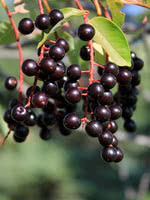Mon-Fri 9am - 5pm Mountain time
Western Chokecherry vs Canada Plum & American Plum
Prunus virginiana var. demissa
Prunus nigra and americana
Western Chokecherry is a shrub or small tree commonly used for farmstead and field windbreaks.
It produces white flowers in the spring and edible dark purple fruit that matures between September and October. Its cherries are great for making for making jams, jellies or wine, but are not very palatable for raw eating.
Canada and American Plum are almost identical in appearance and growth needs. These plants are short and stout fruit trees native to North America.
This hardy ornamental is excellent for both city dwellings as well as rural areas. During the spring, the white and pink blossoms are long lasting. The tasty fruit is suitable for fresh eating, baking, and preserves. These trees are not widely distributed and pure seed can be hard to come by.
Both are commonly used as rootstock and are considered universal pollinizers for other plum varieties.
Western Chokecherry Quick Facts
Canada Plum & American Plum Quick Facts
Toxicity: toxic to horses, cattle, etc.)

